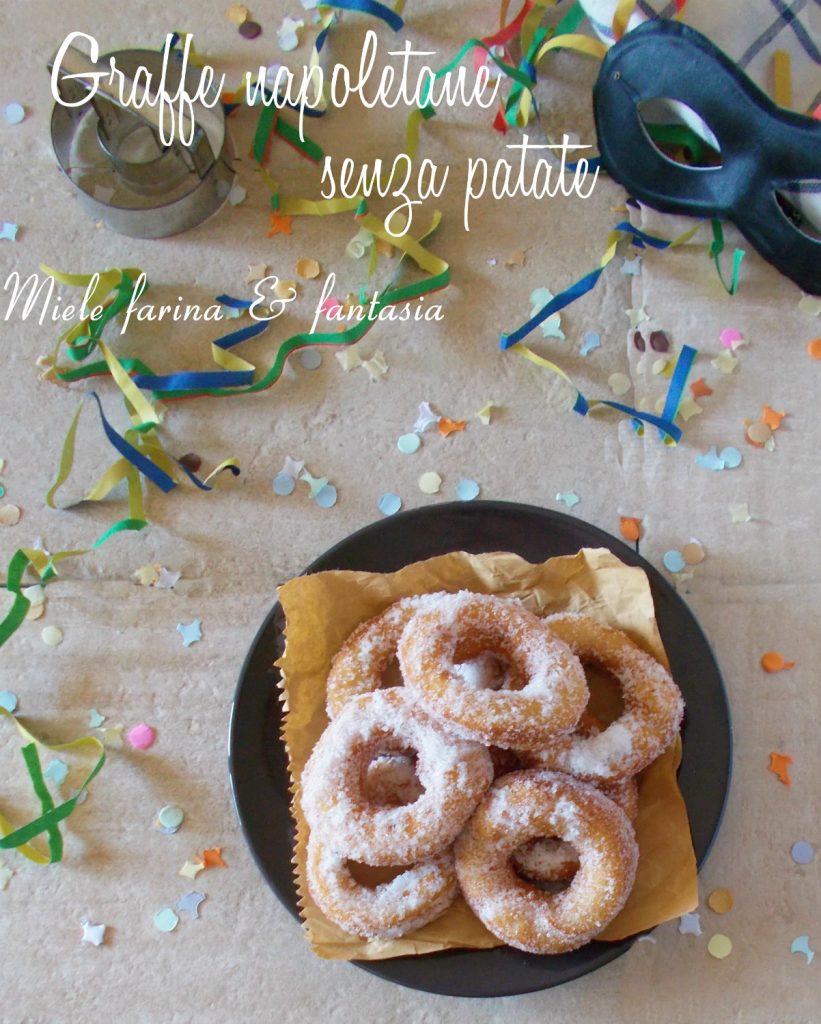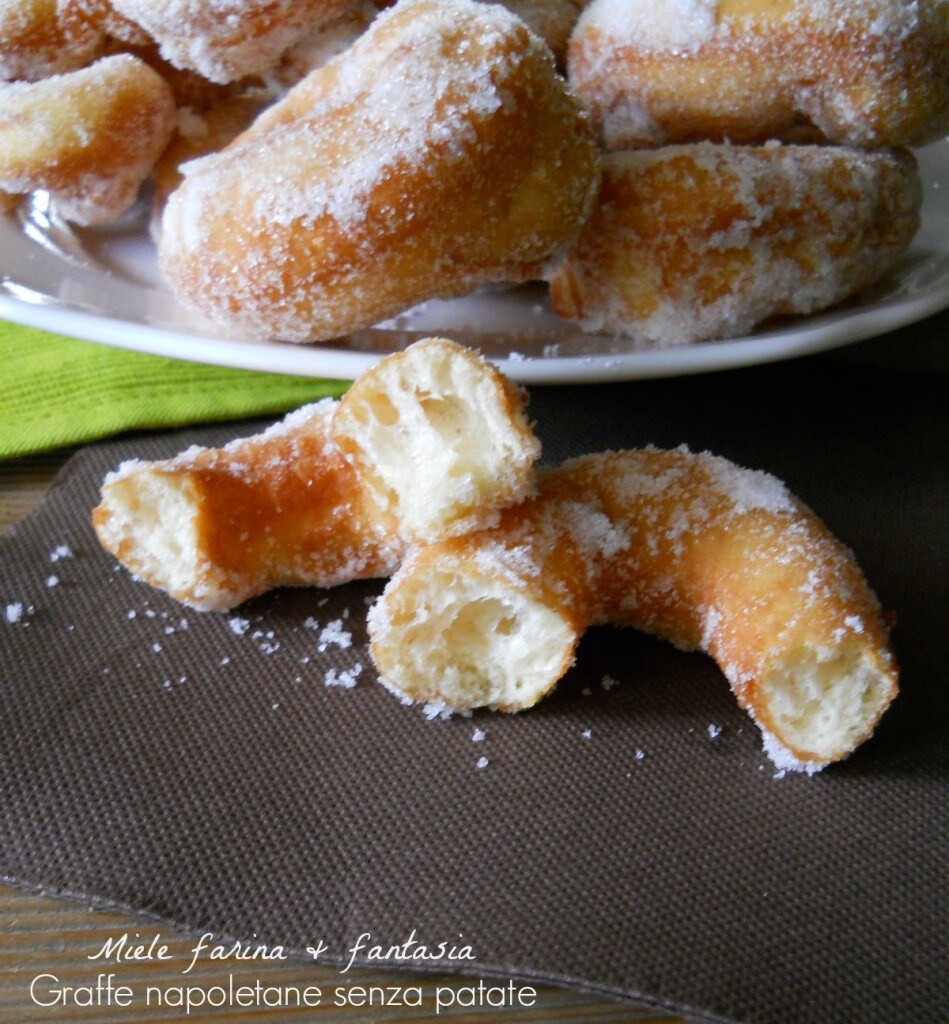Neapolitan graffe without potatoes are exquisite and delicious fried sweet pastries made from leavened dough that can be enjoyed for breakfast or prepared for special occasions. It’s a dessert that has variations; in fact, some prepare them by adding potatoes to the dough, and there are various recipes online. I make them both ways and they are very tasty, but I prefer this one because the graffe remain soft even after a few hours. With this same recipe, we can also make krapfen or doughnuts, or whatever we choose to call them. According to Wikipedia, the term “graffa” has its etymological origins in ancient German “krafo” (from which the term “krapfen” also derives), meaning hook, claw, which became “krappa” in Gothic, eventually arriving at “graffa” in Neapolitan. Other hypotheses suggest Caecilie Kraps, a Viennese pastry chef, invented these sweets. Either way, they are so good that, regardless of who invented them, they are worth tasting at least once a year, and as the Latins might have said in this case: “Semel in anno licet gustare”.

- Difficulty: Easy
- Cost: Cheap
- Rest time: 3 Hours
- Preparation time: 15 Minutes
- Portions: 30
- Cooking methods: Frying
- Cuisine: Italian
- Seasonality: Autumn, Winter, and Spring, Carnival
Ingredients
- 4 cups All-purpose flour
- 0.35 oz Fresh baker's yeast
- 0.8 cup Water
- 1 tsp Fine salt
- 1 tbsp Granulated sugar
- 2 Large whole eggs
- 3.5 tbsp Butter
- to taste Lemon zest
Preparation
First, sift the flour into a bowl.
Dissolve the yeast in a tablespoon of water (taken from the 0.8 cup), add half of the flour with another 0.4 cup of water. Knead until a more or less creamy mixture is formed.
Add the remaining flour, salt, sugar, aromas, eggs, the butter cut into small pieces, and knead, pouring the remaining water little by little (the amount of water may vary slightly based on the flour’s absorption capacity, external temperature, and humidity).
Knead until all the ingredients are combined and the butter is perfectly incorporated (by hand it takes about 15 minutes; with a mixer about 10 minutes).
You should obtain a smooth, soft dough, easy to work with, and not sticky to the hands. Let it rest in a covered bowl for about 20-30 minutes at most (to make it easier to roll out).
After the resting time, roll out the dough into a rectangle, using a rolling pin, on a lightly floured work surface. The thickness of the sheet, as seen in the photos below, should be about the thickness of a finger.
There are two methods to shape the graffe:
1) After rolling out the dough, you can cut out disks with a hole in the center (using a donut cutter; or, if absent, glasses of different sizes, one larger for the donut and the other smaller, like a shot glass, for the hole in the center) and then let them rise. This is not one of my preferred methods because it creates too many dough scraps that would need to be re-kneaded, rested again, and then shaped into donuts, unless you let the scraps rise as they are…The taste certainly wouldn’t change.
2*) From the obtained rectangle, cut strips of dough about the width of a finger, as seen in the photo above, stretch them a bit at the ends, pulling them gently. Cut the strips into two or more parts (depending on how large you want the graffe to be), work them a bit with your hands to make them into a sort of snake, close them into a horseshoe shape by overlapping the two ends, which you will seal with a finger press on the dough. This is my preferred method, even though it’s a bit more laborious, because I manage to get many more donuts without waste.
Finally, let them rise until doubled, on baking sheets covered with parchment paper, spacing them at least by a finger.
Graffe cooking. Prepare a large bowl with granulated sugar. With the help of scissors, cut the parchment paper around the graffe into squares; this way, we can lift them and fry them one by one without issues and without them sticking to our hands.
Heat the oil well in a pot with high edges and start frying the graffe directly on their parchment paper square, which will detach as soon as it comes into contact with the hot oil. Our sweets should become golden on both sides (about 2/3 minutes), so we need to turn them in the oil several times with two spoons. Do not fry too many graffe at once as it will lower the oil temperature, ruining the final result.
As soon as they are ready, golden and swollen, drain them well from the oil, immediately pass them in sugar, and then place them on the serving plate. It’s important that the graffe are passed in sugar as soon as they are taken out of the oil.
We can also freeze our Neapolitan graffe without potatoes before letting them rise; this way, we can have them ready when needed: place the already formed graffe next to each other on a tray covered with parchment paper. Cover the tray well with plastic wrap and put it in the freezer. Once they are perfectly frozen, transfer them into a large food bag and leave them in the freezer. When needed, let them thaw at room temperature and rise.


